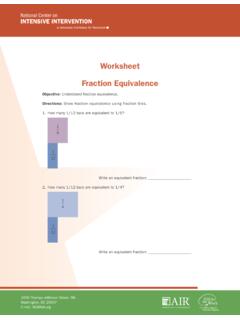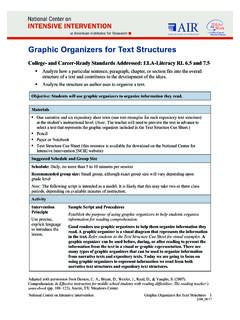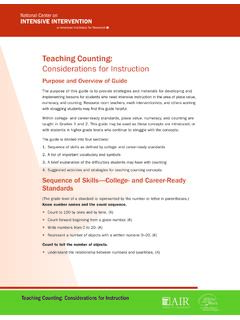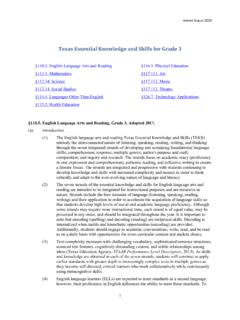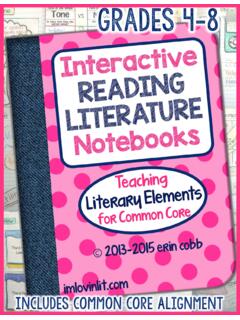Transcription of Word Knowledge: Semantic Feature Analysis
1 Word knowledge : Semantic Feature Analysis Adapted with permission from the Meadows Center for Preventing Educational Risk. Denton, C. A., Bryan, D., Wexler, J., Reed, D., & Vaughn, S. (2007). Effective instruction for middle school students with reading difficulties: The reading teacher s sourcebook (pp. 155 167). Austin, TX: Meadows Center. Retrieved from National Center on Intensive Intervention Semantic Feature Analysis 1 0447_02/17 College- and Career-Ready Standards Addressed: , , Determine the meaning of words and phrases as they are used in a text, including figurative and connotative meanings; analyze the impact of a specific word choice on meaning and tone. Determine the meaning of words and phrases as they are used in a text, including figurative, connotative, and technical meanings.
2 Read and comprehend complex literary and informational texts independently and proficiently. Objective: Students will learn how to complete a Semantic Feature grid to help them understand connections between words in text. Materials One short text at appropriate instructional level. Whiteboard, overhead, or some type of visual projector for the class to view during instruction. Pencil. Paper or notebook. Semantic Feature Analysis Sheet (see below). Suggested Schedule and Group Size Schedule: Daily, no more than five minutes to 10 minutes per session. Recommended group size: Small group, although exact group size will vary depending upon grade level. Note: The following script is intended as a model.
3 Activity Intervention Principle Use precise, explicit language to introduce the lesson and its purpose. Sample Script and Procedures We must know the meanings of the words we read in order to understand a text, and we can use strategies to help us learn the meanings of new words . Good readers use Semantic Feature Analysis to help them organize connections between words and information in text. You can use Semantic Feature Analysis to connect your background knowledge to new words or information. National Center on Intensive Intervention Semantic Feature Analysis 2 What does Semantic Feature Analysis do? (Helps us to organize the connections among items of information in text by connecting background knowledge to new words .)
4 That s right. Today, we are going to focus on creating a Semantic Feature Analysis grid. Then, we will use our grid to help us organize information from text. Activate background knowledge and connect it to information in the lesson. During our lesson today, we will learn how to use Semantic Feature Analysis to help us organize information from text. Like Semantic mapping, Semantic Feature Analysis uses a graphic organizer to show relationships between words . This time, the graphic organizer is a grid. We will practice using a Semantic Feature Analysis grid when we read today. What is a Semantic Feature Analysis grid? (A visual illustration or grid that organizes information to help us understand the connections between words .)
5 Use study aides such as graphic organizers to help students learn the steps of a new strategy. Introduce the Semantic Feature Analysis Sheet to serve as a guide for the students to use as they learn how to create a Semantic Feature Analysis grid and use the strategy of Semantic Feature Analysis to organize essential information from a text. On the Analysis sheet, review the organization of the grid. The Semantic Feature Analysis Sheet includes a nearly complete gird on the concept of mammals. The grid includes key words and features or characteristics of mammals. In the grid s left column are words that relate to the concept. In its top row are features of the concept. This Semantic Feature Analysis grid includes examples of mammals in the left column and features of mammals in the top row.
6 The grid displays the features that are applicable to the words by using a plus sign (+) to indicate that the Feature is present or a minus sign ( ) to indicate that the Feature is not present. For example, a bear is an example of a mammal. The features of a bear are marked by a plus sign if the bear has that Feature or by a minus sign if a bear does not have that Feature . Use modeling to demonstrate how to implement the strategy. Later in class you will create a Semantic Feature Analysis grid about a new topic that is in your text for today s reading; but let s practice with this grid first. As a class, let s all read the features across the top row of the grid. After we read a Feature , let s define what the Feature is.
7 What is the first Feature ? (Has hair or fur.) Yes, has hair or fur. Does a bear have hair or fur? Yes, so we write a plus sign to indicate that a bear has hair or fur. Some bears have different color fur. Polar bears have white fur. Grizzly bears have brown fur. Black bears have black fur. Panda bears have white and black fur. National Center on Intensive Intervention Semantic Feature Analysis 3 What is the second Feature ? (Vertebrate.) Who can tell me what a vertebrate is? (An animal that has a backbone.)That s right, a vertebrate is an animal that has a backbone. Is a bear a vertebrate? (Yes.) That s right, so we write a plus sign to indicate that a bear is a vertebrate. A bear has a backbone and a skeleton.
8 If a bear did not have a backbone, it would be called an invertebrate. Provide opportunities for practice with monitoring and feedback. Group the students in pairs and provide time for the students to discuss the features on the grid. Work with your partner to read the rest of the features across the top row of the grid. Try to define each Feature with your partner s help. Allow the students adequate time to read and discuss the definitions of the Feature words or phrases. While students read, monitor their reading. Provide students with corrective feedback if they do not read or define the words correctly. If some students finish while others are still reading, prompt them to move on to the features of a bat.
9 Gradually shift responsibility for completing the task to students. After partners are finished, allow pairs to share which Feature words they knew. Now let s look at the human example. We need to answer the first three boxes to complete the row. Do humans have hair or fur? (Yes.) Write a plus sign to indicate that a human has hair. Work with your partner to finish the next two features. Provide students a short time to complete the next two features. Allow students time to share responses. Distribute the text you have chosen. Read the title and the first paragraph together. Explain to the students that they will create their own Semantic Feature Analysis grid from the information in the text.
10 I will begin by reading the title of our text. Partners check to make sure that your partner is in the correct spot to follow along. Then we ll read the first paragraph together. Let s begin. After reading the first paragraph, ask students to brainstorm words related to the topic of the text. Write appropriate student responses on the board or projector. Ask questions to prompt students to say key words or examples from the text. Prompt students to think of synonyms to extend their vocabulary of descriptor words to include. Now we ll use the blank Semantic Feature Analysis Grid to create a grid from the information in the text. With your partner, write the topic or concept of the text on the line above the grid.


